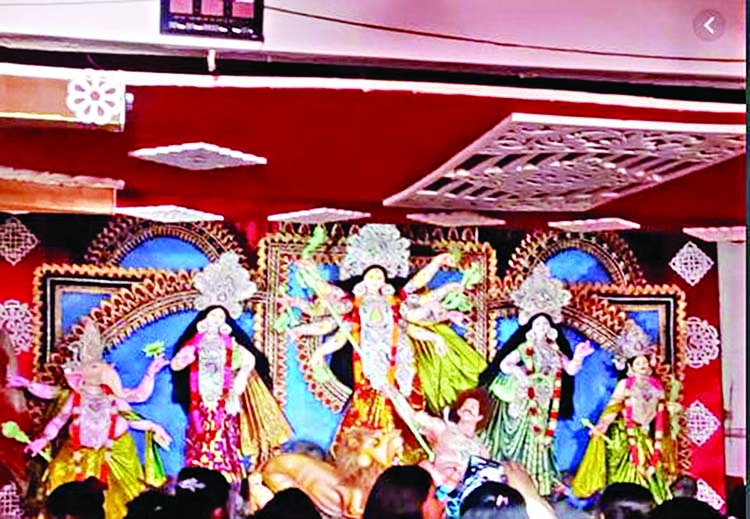Mahanabomi Puja celebrated in Ctg -The Asian Age

The Puja pandals and temples in the port city and elsewhere in the district are now bustling with thousands of Hindu devotees as they thronged the mandaps to celebrate their biggest religious festival of Durga Puja.
The festivity reached its peak as devotees visit different Puja pandals from throughout the day to have last glance of goddess Durga seeking blessings for their well-being.
All puja mandaps are given decorative looks with colorful designs and lights while additional law enforcers have been deployed in all the temples in the city to maintain law and order situation during the festival.
Chattogram Metropolitan Police (CMP), district police and Puja committee source said, there was no report of any untoward incidents centering the Durga puja celebrations.
CMP sources said a five to seven-member team of law enforcers has been deployed at each Puja Mandaps and adequate numbers of law enforcer including, Armed Police Battalions members have already been deployed at all necessary points particularly at Hindhu community residing area to maintain law and order.
Besides, plainclothes police men, members of the different intelligent agencies including RAB personnel are also being kept vigil in the area. Besides, district and Chattogram Metropolitan Police (CMP) have already opened separate control rooms at their respective headquarters to monitor the situation of 2144 puja Mondops in the district including 270 puja Mondops in the port city.
As per the Hindu mythological legends, it is believed that the first ever Durga Puja was performed by Lord Rama in the Hindu month of Ashwin (September-October). It is said that Lord Rama invoked the blessing of the Goddess before declaring war on the mighty demon, King Ravana.
This Durga Puja was quite different from the traditional worship of the mother goddess, therefore, this puja ceremony is also known as 'akal-bodhan', which stands for out-of-season worship.
As per the legend, before going into the battle against the mighty Ravana, who had acquired many boons from the Gods, Lord Rama worshipped the 'Mahishasura Mardini' or the slayer of the buffalo-demon for the first time during this time of the year. It is said he made an offering of 108 blue lotuses and lit 108 lamps to seek the blessings of the Goddess. Since then, the tradition of Durga Puja began.
As per the factual history, it is believed that large scale and lavish worship of Goddess Durga began in the late 1500s by wealthy landlords or zamindars of Dinajpur and Mandla in the region of Bengal. During 18th century, Raja Nabakrishna Deb of Shobhabajar, under the patronage of British, organized an elaborate puja in his household.
These grand celebrations were open for the royalty as well as peasantry and thus, brought Durgostavs into the public domain. However, by 19th century, the pujas started to be more about community gathering rather than show of money and power by the zamindars.
The major step towards the beginning of community puja can be traced to twelve friends of Guptipara in Hoogly, West Bengal, who were the first to collect money from the local residents and organize the first small-scale community puja in 1970, which came to be known as 'baro-yaari' puja (twelve-pal puja). This concept of baro-yaari puja was replicated in Kolkata by Raja Harinath of Cossimbazar, who performed such puja at his ancestral home, Murshidabad from 1824 to 1831.
The small-scale baro-yaari puja gradually transformed into a large-scale sarbajanin, or community puja, by 1910. The first such puja, which was organized by full public contribution, public control and public participation, was established in Baghbazar in Kolkata by the Sanatan Dharmotsahini Sabha. The rise of such community Durga Puja in the 18th and the 19th century is greatly credited for the development of the Hindu Bengali culture.
In contemporary times, it can be safely said that Durga Puja has transcended the boundaries of religion and has become a magnificent cultural event that promotes social harmony and well being. The festival is heralded as one of the largest outdoor art festivals around the globe. It provides the Bengali community an opportunity to showcase its art and culture throughout the world.
Since 1990s, the pandals (makeshift tents) were no longer seen like a place to keep the idols, but as an extension of the Durga Puja itself. Thus, stylistic elements began to be added to its exteriors as well as interiors. Today, the pandals are made with painstaking craftsmanship and detailed work that are absolutely thrilling.
The tableaus and idols used for worship have also gone through dynamic changes over the period of time, though the basics are the same as in the early times. Even now, Durga is worshipped along with her four children and some attending deities.
However, in earlier times, these all were part of a single tableau, nowadays, they are all depicted individually. Durga Puja has immensely evolved since the medieval times. Today, modern aspects as well as technology have become its integral part but the essence of religious devotion for the Mother Goddess remains the same.
Meanwhile, leaders of different political parties irrespective of the religion, cast and creed are also visiting the Puja pandals to exchange greetings and pleasantries with their community members.As a part of the rituals of the last day of celebration, 'Nabomi Vhog' (feast) was offered to the goddess Durga by the devotees.
The celebration will end through immersion of the idols of goddess Durga on Bijoya Dashami on Tuesday.The five-day festival, celebrating the arrival of Goddess Durga on earth, will end on Tuesday, through immersion of goddess.
